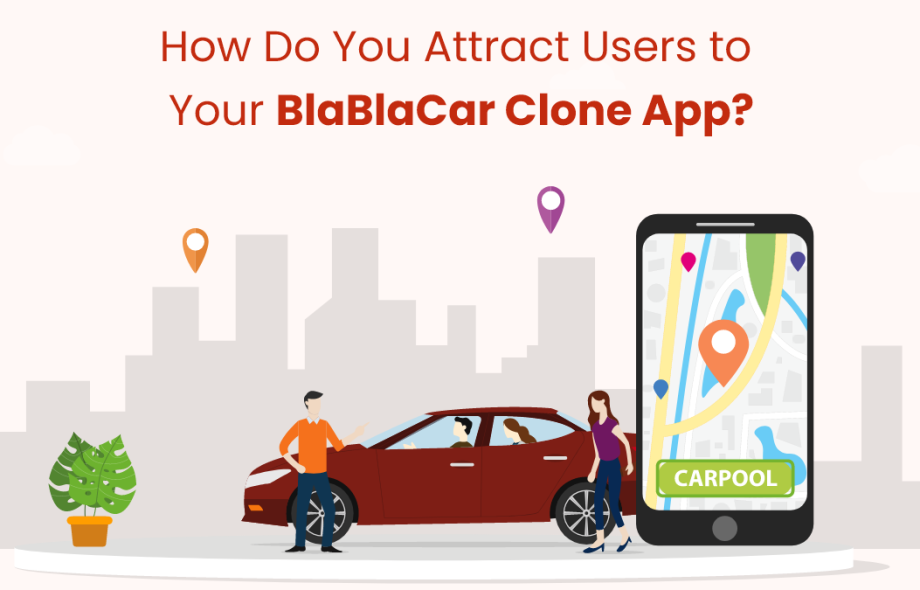Attracting users to your BlaBlaCar clone app requires a strategic approach that combines effective marketing tactics, compelling features, and a seamless user experience. Here’s a comprehensive guide on how to successfully attract users and build a thriving community around your ridesharing platform.
1. Define Your Target Audience
Understanding your target audience is crucial for crafting tailored marketing strategies and app features that resonate with their needs and preferences. Identify demographic characteristics, travel behaviors, and pain points to create targeted messaging and attract the right users.
2. Create a Compelling Value Proposition
Develop a unique value proposition (UVP) that differentiates your BlaBlaCar clone app from competitors. Highlight key features, benefits, and reasons why users should choose your platform over others. Emphasize aspects like affordability, safety, convenience, or unique service offerings to attract user interest.
3. Optimize App Store Presence
Enhance your app’s visibility and discoverability by optimizing its presence on app stores (App Store and Google Play). Implement App Store Optimization (ASO) techniques such as:
- Keyword Optimization: Use relevant keywords in app titles, descriptions, and metadata to improve search rankings.
- High-Quality Visuals: Include attractive app icons, screenshots, and app previews that showcase key features and user interface.
- Compelling Descriptions: Write clear and engaging app descriptions that highlight benefits and encourage downloads.
4. Leverage Digital Marketing Channels
Utilize digital marketing channels to reach your target audience effectively:
- Social Media Marketing: Promote your app on platforms like Facebook, Instagram, Twitter, and LinkedIn. Create engaging content, run targeted ads, and leverage influencer partnerships to increase brand awareness and attract users.
- Search Engine Marketing (SEM): Use paid search advertising (Google Ads) to target users searching for ridesharing services or related keywords. Optimize ad campaigns for conversions and monitor performance metrics to refine strategies.
5. Content Marketing and Blogging
Establish thought leadership and attract organic traffic through content marketing:
- Blog Posts and Articles: Write informative blog posts, articles, and guides related to ridesharing, travel tips, and industry trends. Publish content on your website or guest blog on relevant platforms to drive traffic and establish credibility.
- SEO Strategies: Optimize content with relevant keywords, backlinks, and SEO best practices to improve search engine rankings and attract users actively seeking ridesharing solutions.
6. Offer Incentives and Referral Programs
Encourage user acquisition and retention by offering incentives and referral programs:
- Promotional Discounts: Provide discounts, free rides, or credits for first-time users to incentivize app downloads and initial usage.
- Referral Rewards: Implement a referral program where existing users earn rewards (e.g., credits, discounts) for referring friends and family to join the platform. This creates a viral loop of user acquisition and expands your user base organically.
7. Build Trust and Social Proof
Enhance user trust and credibility through:
- User Reviews and Ratings: Encourage users to leave reviews and ratings after each ride. Highlight positive testimonials and respond promptly to negative feedback to demonstrate your commitment to customer satisfaction.
- Trust Badges and Certifications: Display trust badges, security certifications, or compliance with data protection regulations (e.g., GDPR) to reassure users about their privacy and security.
8. Engage with User Communities
Participate in online forums, community groups, and social media discussions related to ridesharing and travel:
- Community Engagement: Engage with users, respond to inquiries, and actively participate in discussions to build relationships and foster community trust.
- User-Generated Content: Encourage users to share their ride experiences, testimonials, and travel stories on social media. Feature user-generated content to showcase real-life interactions and build authenticity.
9. Continuous Improvement and Feedback
Listen to user feedback and continuously improve your app based on user preferences and industry trends:
- Feedback Loops: Implement feedback mechanisms such as surveys, in-app feedback forms, and usability testing to gather insights and identify areas for enhancement.
- Iterative Updates: Release regular app updates with new features, performance improvements, and bug fixes. Communicate updates transparently to users to demonstrate ongoing commitment to app quality and user satisfaction.
10. Monitor Metrics and Adjust Strategies
Monitor key performance indicators (KPIs) such as app downloads, user engagement, retention rates, and conversion metrics:
- Analytics Tools: Use analytics tools (e.g., Google Analytics, Firebase Analytics) to track user behavior, app usage patterns, and marketing campaign performance.
- Data-Driven Decisions: Analyze data to evaluate the effectiveness of marketing efforts, identify successful strategies, and optimize campaigns for maximum user acquisition and retention.
Conclusion
Successfully attracting users to your BlaBlaCar clone app requires a strategic blend of marketing initiatives, compelling value propositions, and continuous user engagement. By understanding your target audience, optimizing app store presence, leveraging digital marketing channels, offering incentives, building trust, and listening to user feedback, you can attract a loyal user base and establish a prominent presence in the competitive ridesharing market. Continuously adapt your strategies based on user insights and industry trends to sustain growth and maximize app success over time.
 :
https://whitelabelfox.com/blablacar-clone-app/
:
https://whitelabelfox.com/blablacar-clone-app/












